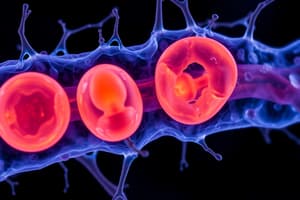Podcast
Questions and Answers
What molecule is the primary energy carrier produced by mitochondria?
What molecule is the primary energy carrier produced by mitochondria?
- Adenosine triphosphate (ATP) (correct)
- Nicotinamide adenine dinucleotide (NADH)
- Cyclic adenosine monophosphate (cAMP)
- Glucose
Mitochondrial DNA is inherited only from the father.
Mitochondrial DNA is inherited only from the father.
False (B)
What function do the two membranes of the mitochondria serve?
What function do the two membranes of the mitochondria serve?
They function to produce energy.
Muscle cells, liver cells, and kidney cells have a high number of __________ due to their energy needs.
Muscle cells, liver cells, and kidney cells have a high number of __________ due to their energy needs.
Match the following types of cells with their related mitochondrial function:
Match the following types of cells with their related mitochondrial function:
Flashcards are hidden until you start studying
Study Notes
Mitochondria Overview
- Mitochondria are membrane-bound organelles that produce the majority of a cell's chemical energy.
- Energy generated is stored in adenosine triphosphate (ATP), a crucial molecule for cellular functions.
Structure and Inheritance
- Mitochondria possess their own small chromosomes, distinct from nuclear DNA.
- Mitochondrial DNA is typically inherited exclusively from the mother.
Membrane Composition
- Mitochondria are unique for having two membranes, an outer and an inner membrane.
- The dual membrane structure is essential for energy production processes.
Energy Production
- Mitochondria convert various chemicals through metabolic pathways to generate ATP.
- Energy conversion involves high-energy phosphate bonds in ATP, which power cellular reactions.
Variation in Mitochondrial Presence
- Different cell types have varying quantities of mitochondria based on energy demands:
- Muscle cells contain a high number of mitochondria for energy-intensive activity.
- Liver and kidney cells also have numerous mitochondria due to their metabolic roles.
- Brain cells rely on mitochondrial energy for proper function.
Impact of Mitochondrial Dysfunction
- Defects in mitochondrial pathways can lead to symptoms affecting muscles, brain, and kidneys.
- Mitochondrial dysfunction is linked to various diseases, though many remain unidentified.
Studying That Suits You
Use AI to generate personalized quizzes and flashcards to suit your learning preferences.




